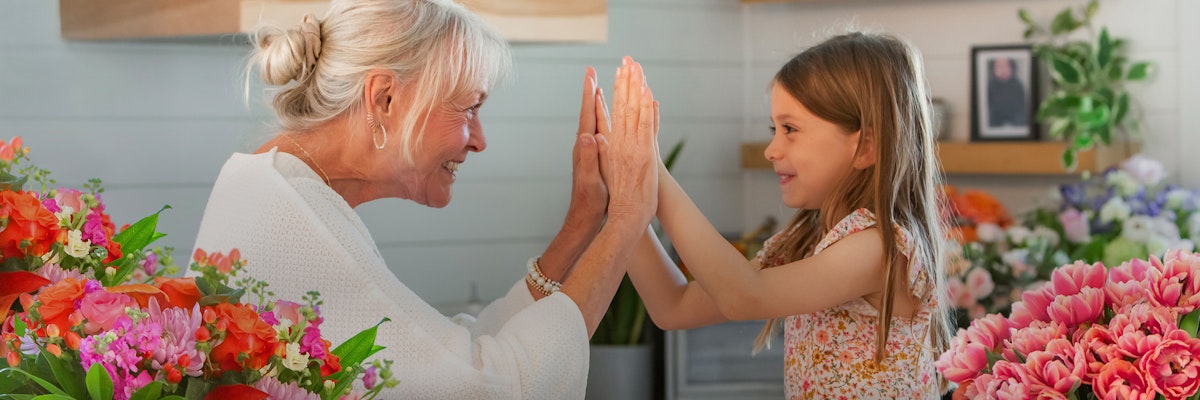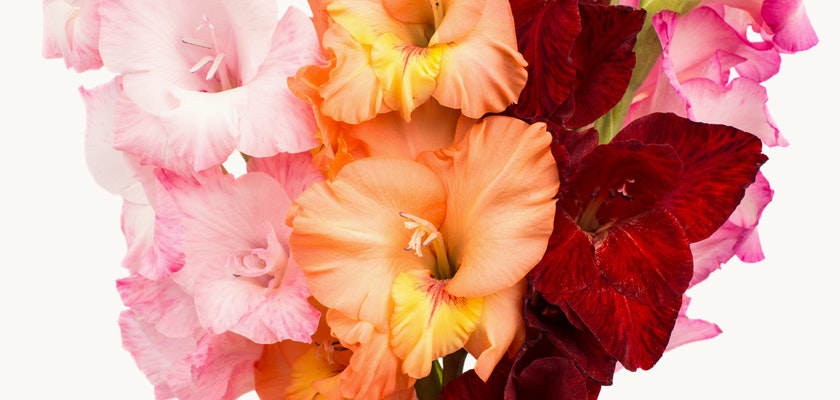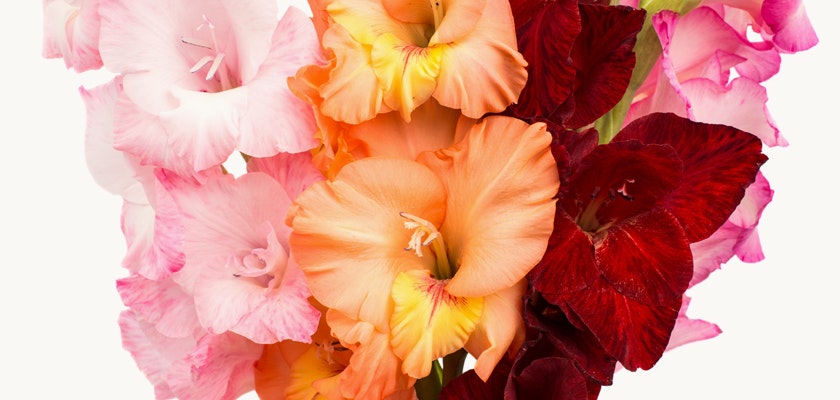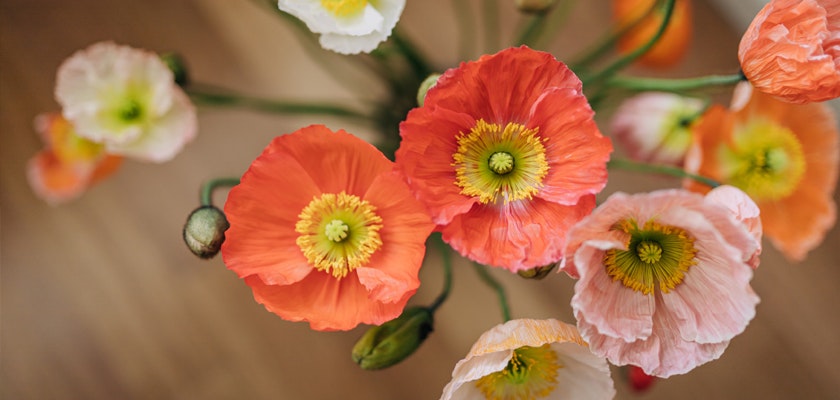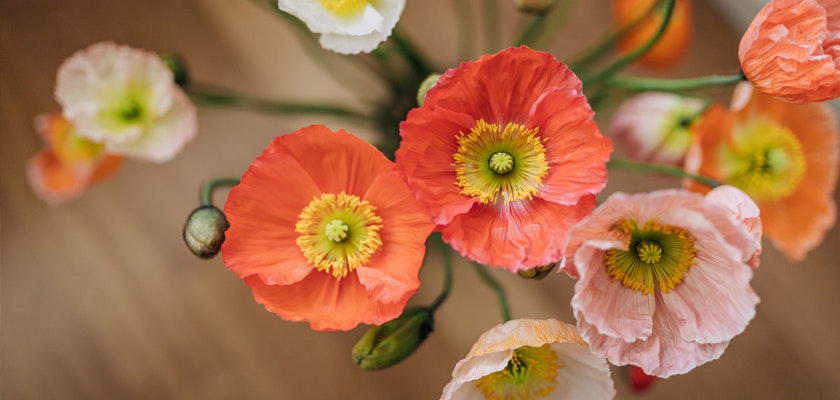August Birth Flowers: The Gladiolus and Poppy
Just as every month has a birthstone, it also has flowers that represent it. For those born in August, the gladiolus and poppy hold special significance. These flowers aren’t just beautiful; they’re imbued with rich histories and meanings that have transcended cultures and time periods.
Discover the significance and care of August birth flowers, gladiolus and poppy.
The gladiolus stands tall and proud, known for its striking appearance and symbolic association with strength and integrity. This flower’s name is derived from the Latin word "gladius," meaning sword, reflecting its sword-like leaves and the valiant qualities it embodies. On the other hand, the poppy, often associated with sleep, peace, and death, carries an equally powerful but different set of symbolisms. This flower, with its delicate petals and vibrant colors, has been woven into the fabric of wartime remembrance and acts as a poignant reminder of the sacrifices made during conflicts.
Discover the significance and care of August birth flowers, gladiolus and poppy.
The gladiolus stands tall and proud, known for its striking appearance and symbolic association with strength and integrity. This flower’s name is derived from the Latin word "gladius," meaning sword, reflecting its sword-like leaves and the valiant qualities it embodies. On the other hand, the poppy, often associated with sleep, peace, and death, carries an equally powerful but different set of symbolisms. This flower, with its delicate petals and vibrant colors, has been woven into the fabric of wartime remembrance and acts as a poignant reminder of the sacrifices made during conflicts.
Both flowers are deeply embedded in cultural traditions and have various practical uses. For instance, the gladiolus has a storied past that includes medicinal applications in ancient times, while the poppy has been used for both its aesthetic beauty and its extractable substances, such as opium. Despite their differences, these flowers share a common thread: they both captivate the senses and stir the soul with their unique beauty and profound meanings.
In gardens and floral arrangements alike, the gladiolus and poppy bring a sense of elegance and emotion. Their vivid hues can brighten any space, making them popular choices for bouquets, centerpieces, and garden displays. Each bloom tells a story, and when given as gifts, they convey heartfelt messages that resonate on a deeper level.
Whether celebrating a birthday, commemorating a loved one, or simply enjoying the beauty of nature, the gladiolus and poppy offer more than just visual appeal. They remind us of the complexities of life, the endurance of the human spirit, and the importance of memory and honor.
At BloomsyBox, we appreciate the depth and diversity of these August birth flowers. We celebrate their unique qualities by creating floral arrangements that capture their essence and share their stories. Our carefully curated selections ensure that each bouquet is not only stunning but also meaningful, perfect for commemorating the special moments in life.
Explore the fascinating world of gladiolus and poppies in the sections below, where we'll delve deeper into their history, significance, and care tips. Learn interesting facts about these captivating blooms and discover why they hold a special place in the hearts of many.
Gladiolus
History and Significance
The gladiolus, also known as the "sword lily," is a flower that commands attention with its tall, striking spikes of blossoms. Its name comes from the Latin word "gladius," meaning sword, a nod to its sword-shaped leaves. This flower has a storied past that dates back to ancient times, where it was admired not only for its beauty but also for its symbolic associations.
In ancient Rome, gladiolus flowers were often worn by gladiators who fought in the Colosseum. The flower was believed to bring them strength and protection, enhancing their valor in battle. Because of this, the gladiolus became a symbol of strength and moral integrity, embodying the qualities of a true warrior.
Native to South Africa, the gladiolus was introduced to Europe in the 18th century and quickly became popular among gardeners and botanists. By the 19th century, hybridization efforts had created a wide variety of colors and forms, making the gladiolus a favorite in Victorian gardens. Its dramatic appearance and range of hues made it a symbol of admiration and infatuation during this period.
Today, the gladiolus is often used to convey messages of honor and remembrance. It is a popular choice for memorial services and tributes, symbolizing the strength of character and resilience of those being honored. Moreover, the flower’s association with infatuation and love at first sight adds a romantic touch to its already rich tapestry of meanings.
The gladiolus also holds a special place in cultural celebrations and events. In many parts of the world, it is used in festivals and ceremonies to symbolize victory and triumph. Its presence in gardens and floral displays continues to inspire admiration and respect, making it a timeless favorite.
With its historical significance and symbolic depth, the gladiolus remains a powerful flower that speaks to the heart. Whether used in a bouquet or planted in a garden, it brings a sense of grandeur and meaning to any setting.
At BloomsyBox, we take pride in featuring gladiolus in our floral arrangements. We understand the importance of this flower and aim to highlight its beauty and significance in every bouquet we create. Our commitment to quality ensures that each arrangement is crafted with care, capturing the essence of this remarkable bloom.
Care Tips
Caring for gladiolus requires attention to several key factors to ensure they thrive and display their full beauty. Here are some essential tips for nurturing these stunning flowers:
1. Watering: Gladiolus plants need regular watering, especially during dry spells. Keep the soil consistently moist but avoid waterlogging, which can lead to root rot. Water the base of the plant to prevent wetting the foliage.
2. Sun Exposure: These sun-loving flowers require full sunlight to flourish. Ensure they receive at least six hours of direct sunlight daily. Adequate sunlight promotes healthy growth and vibrant blooms.
3. Soil Needs: Gladioli prefer well-drained, fertile soil rich in organic matter. Improve soil drainage and fertility by adding compost or well-rotted manure before planting. This helps retain moisture while preventing waterlogging.
4. Planting Depth: Plant gladiolus corms (bulbs) about 4-6 inches deep and 6-8 inches apart. Planting at the correct depth ensures stability and encourages robust growth. Grouping corms in clusters creates a more impressive display.
5. Staking: Due to their height, gladiolus stalks may require support to prevent toppling in windy conditions. Use bamboo stakes or other supports to keep the stems upright. Tie the stems gently to the stakes using soft garden ties.
6. Fertilization: Feed gladioli with a balanced, water-soluble fertilizer every 4-6 weeks during the growing season. This provides essential nutrients for healthy growth and abundant blooms. Avoid over-fertilizing, as it can lead to excessive foliage growth at the expense of flowers.
7. Mulching: Apply a layer of mulch around the base of the plants to help retain soil moisture and regulate temperature. Mulching also suppresses weeds, reducing competition for nutrients and water.
8. Pest Control: Gladiolus plants can be susceptible to pests such as aphids, thrips, and spider mites. Inspect plants regularly and treat infestations promptly with insecticidal soap or neem oil. Maintaining good garden hygiene helps prevent pest problems.
9. Disease Management: Ensure proper air circulation around plants to reduce the risk of fungal diseases like botrytis and fusarium wilt. Remove and dispose of any infected plant material to prevent the spread of disease.
10. Winter Care: In regions with cold winters, dig up the corms after the first frost. Allow them to dry, then store them in a cool, dry place for the winter. Replant in spring for another season of stunning blooms.
Interesting Facts About Gladiolus:
1. Symbolism in Literature and Art: Gladiolus has been featured prominently in literature and art throughout history. In Victorian times, the flower was often included in poetry and paintings to symbolize moral integrity and strength. The dramatic appearance of gladiolus spikes made them a favorite subject for artists seeking to convey powerful emotions.
2. Medicinal Uses in Ancient Times: The gladiolus wasn't just admired for its beauty; it also had practical applications in ancient medicine. Herbalists used parts of the plant to treat a variety of ailments, including colic and respiratory issues. The corms were sometimes ground into a paste and applied to wounds to promote healing. While not commonly used in modern medicine, these historical uses highlight the versatility of the gladiolus.
Both flowers are deeply embedded in cultural traditions and have various practical uses. For instance, the gladiolus has a storied past that includes medicinal applications in ancient times, while the poppy has been used for both its aesthetic beauty and its extractable substances, such as opium. Despite their differences, these flowers share a common thread: they both captivate the senses and stir the soul with their unique beauty and profound meanings.
In gardens and floral arrangements alike, the gladiolus and poppy bring a sense of elegance and emotion. Their vivid hues can brighten any space, making them popular choices for bouquets, centerpieces, and garden displays. Each bloom tells a story, and when given as gifts, they convey heartfelt messages that resonate on a deeper level.
Whether celebrating a birthday, commemorating a loved one, or simply enjoying the beauty of nature, the gladiolus and poppy offer more than just visual appeal. They remind us of the complexities of life, the endurance of the human spirit, and the importance of memory and honor.
At BloomsyBox, we appreciate the depth and diversity of these August birth flowers. We celebrate their unique qualities by creating floral arrangements that capture their essence and share their stories. Our carefully curated selections ensure that each bouquet is not only stunning but also meaningful, perfect for commemorating the special moments in life.
Explore the fascinating world of gladiolus and poppies in the sections below, where we'll delve deeper into their history, significance, and care tips. Learn interesting facts about these captivating blooms and discover why they hold a special place in the hearts of many.
Gladiolus
History and Significance
The gladiolus, also known as the "sword lily," is a flower that commands attention with its tall, striking spikes of blossoms. Its name comes from the Latin word "gladius," meaning sword, a nod to its sword-shaped leaves. This flower has a storied past that dates back to ancient times, where it was admired not only for its beauty but also for its symbolic associations.
In ancient Rome, gladiolus flowers were often worn by gladiators who fought in the Colosseum. The flower was believed to bring them strength and protection, enhancing their valor in battle. Because of this, the gladiolus became a symbol of strength and moral integrity, embodying the qualities of a true warrior.
Native to South Africa, the gladiolus was introduced to Europe in the 18th century and quickly became popular among gardeners and botanists. By the 19th century, hybridization efforts had created a wide variety of colors and forms, making the gladiolus a favorite in Victorian gardens. Its dramatic appearance and range of hues made it a symbol of admiration and infatuation during this period.
Today, the gladiolus is often used to convey messages of honor and remembrance. It is a popular choice for memorial services and tributes, symbolizing the strength of character and resilience of those being honored. Moreover, the flower’s association with infatuation and love at first sight adds a romantic touch to its already rich tapestry of meanings.
The gladiolus also holds a special place in cultural celebrations and events. In many parts of the world, it is used in festivals and ceremonies to symbolize victory and triumph. Its presence in gardens and floral displays continues to inspire admiration and respect, making it a timeless favorite.
With its historical significance and symbolic depth, the gladiolus remains a powerful flower that speaks to the heart. Whether used in a bouquet or planted in a garden, it brings a sense of grandeur and meaning to any setting.
At BloomsyBox, we take pride in featuring gladiolus in our floral arrangements. We understand the importance of this flower and aim to highlight its beauty and significance in every bouquet we create. Our commitment to quality ensures that each arrangement is crafted with care, capturing the essence of this remarkable bloom.
Care Tips
Caring for gladiolus requires attention to several key factors to ensure they thrive and display their full beauty. Here are some essential tips for nurturing these stunning flowers:
1. Watering: Gladiolus plants need regular watering, especially during dry spells. Keep the soil consistently moist but avoid waterlogging, which can lead to root rot. Water the base of the plant to prevent wetting the foliage.
2. Sun Exposure: These sun-loving flowers require full sunlight to flourish. Ensure they receive at least six hours of direct sunlight daily. Adequate sunlight promotes healthy growth and vibrant blooms.
3. Soil Needs: Gladioli prefer well-drained, fertile soil rich in organic matter. Improve soil drainage and fertility by adding compost or well-rotted manure before planting. This helps retain moisture while preventing waterlogging.
4. Planting Depth: Plant gladiolus corms (bulbs) about 4-6 inches deep and 6-8 inches apart. Planting at the correct depth ensures stability and encourages robust growth. Grouping corms in clusters creates a more impressive display.
5. Staking: Due to their height, gladiolus stalks may require support to prevent toppling in windy conditions. Use bamboo stakes or other supports to keep the stems upright. Tie the stems gently to the stakes using soft garden ties.
6. Fertilization: Feed gladioli with a balanced, water-soluble fertilizer every 4-6 weeks during the growing season. This provides essential nutrients for healthy growth and abundant blooms. Avoid over-fertilizing, as it can lead to excessive foliage growth at the expense of flowers.
7. Mulching: Apply a layer of mulch around the base of the plants to help retain soil moisture and regulate temperature. Mulching also suppresses weeds, reducing competition for nutrients and water.
8. Pest Control: Gladiolus plants can be susceptible to pests such as aphids, thrips, and spider mites. Inspect plants regularly and treat infestations promptly with insecticidal soap or neem oil. Maintaining good garden hygiene helps prevent pest problems.
9. Disease Management: Ensure proper air circulation around plants to reduce the risk of fungal diseases like botrytis and fusarium wilt. Remove and dispose of any infected plant material to prevent the spread of disease.
10. Winter Care: In regions with cold winters, dig up the corms after the first frost. Allow them to dry, then store them in a cool, dry place for the winter. Replant in spring for another season of stunning blooms.
Interesting Facts About Gladiolus:
1. Symbolism in Literature and Art: Gladiolus has been featured prominently in literature and art throughout history. In Victorian times, the flower was often included in poetry and paintings to symbolize moral integrity and strength. The dramatic appearance of gladiolus spikes made them a favorite subject for artists seeking to convey powerful emotions.
2. Medicinal Uses in Ancient Times: The gladiolus wasn't just admired for its beauty; it also had practical applications in ancient medicine. Herbalists used parts of the plant to treat a variety of ailments, including colic and respiratory issues. The corms were sometimes ground into a paste and applied to wounds to promote healing. While not commonly used in modern medicine, these historical uses highlight the versatility of the gladiolus.
Poppy
History and Significance
The poppy is a flower steeped in symbolism, history, and cultural significance. Known for its delicate petals and vibrant colors, the poppy has captured the imagination of people across different eras and societies. Its associations with sleep, peace, and death make it a flower of profound meaning and emotional resonance.
In ancient times, the Sumerians revered the poppy as the “flower of joy.” Its presence in their culture was a testament to the flower's beauty and the euphoria it was believed to bring. The Greeks and Romans later adopted the poppy, incorporating it into their religious practices and mythology. Wreaths of poppies were often used to adorn statues of gods, symbolizing respect and devotion.
The poppy's connection to sleep and death is rooted in its association with the underworld in Greek and Roman mythology. The flower was linked to Hypnos, the god of sleep, and Morpheus, the god of dreams. This connection extended to its use in funerary rites, where poppies represented eternal rest and consolation for the deceased.
One of the most enduring symbols of the poppy emerged from World War I. The sight of poppies growing on the battlefields of Flanders inspired Lieutenant Colonel John McCrae to write his famous poem "In Flanders Fields." The poem highlighted the resilience of the poppies amidst the devastation of war, turning the flower into a symbol of remembrance and sacrifice. Today, the poppy is widely recognized as the emblem of Remembrance Day, honoring those who lost their lives in conflicts.
Beyond its somber associations, the poppy is also seen as a symbol of beauty, grace, and extravagance. Its vibrant colors, ranging from white and yellow to red and purple, make it a standout in any garden or floral arrangement. In many cultures, the poppy represents admiration for someone's unique charm and allure, making it a popular choice for romantic gestures and celebratory occasions.
The poppy's significance extends to various cultural traditions and celebrations. For example, in China, the poppy symbolizes success and prosperity, often featured in art and festivals. In contemporary times, the flower continues to captivate people's hearts with its delicate beauty and powerful meanings, serving as a reminder of both the fragility and resilience of life.
In addition to its symbolic value, the poppy has practical uses that have been recognized for centuries. The seeds of the poppy are used in culinary applications, adding flavor and texture to a variety of dishes. Poppy seeds are rich in essential nutrients, including calcium, iron, and magnesium, making them a healthy addition to any diet. Moreover, the opium poppy has been historically used for its medicinal properties, providing pain relief and sedation, though its use is strictly regulated today.
At BloomsyBox, we appreciate the multifaceted nature of the poppy. Our floral arrangements featuring poppies are designed to capture their essence and convey their rich symbolism. Whether you're honoring a loved one, celebrating a special occasion, or simply enjoying the beauty of nature, our poppies are carefully curated to make a meaningful impact.
As we explore the history and significance of the poppy, we invite you to discover more about its unique qualities. Learn about its care tips and interesting facts that make the poppy a truly remarkable flower.
Care Tips
Caring for poppies requires attention to their specific needs to ensure they thrive and display their full beauty. Here are some essential tips for nurturing these captivating flowers:
1. Watering: Poppies require minimal watering once established. Water sparingly, allowing the soil to dry out between waterings. Overwatering can lead to root rot, so it's crucial to strike the right balance.
2. Sun Exposure: These sun-loving flowers thrive in full sunlight. Ensure they receive at least six hours of direct sunlight daily to promote healthy growth and vibrant blooms.
3. Soil Needs: Poppies prefer well-drained, fertile soil. Improve soil drainage by adding sand or gravel if necessary. Poorly drained soil can lead to root rot and other issues.
4. Planting Depth: Sow poppy seeds on the soil surface and lightly press them in. Do not cover the seeds with soil, as they need light to germinate. Space seeds about 6 inches apart to allow for adequate air circulation.
5. Fertilization: Poppies do not require heavy fertilization. A light application of balanced fertilizer during the growing season is sufficient. Over-fertilizing can result in excessive foliage growth at the expense of flowers.
6. Mulching: Apply a thin layer of mulch around the base of the plants to help retain soil moisture and regulate temperature. Mulching also suppresses weeds, reducing competition for nutrients and water.
7. Pest Control: Poppies are generally resistant to pests, but they can occasionally be affected by aphids and slugs. Inspect plants regularly and treat infestations promptly with insecticidal soap or natural remedies.
8. Disease Management: Ensure proper air circulation around plants to reduce the risk of fungal diseases like powdery mildew. Avoid overhead watering to prevent moisture from settling on the foliage.
9. Pruning: Deadhead spent blooms to encourage continuous flowering and prevent self-seeding. Remove any damaged or diseased foliage to maintain plant health.
10. Winter Care: In regions with cold winters, most poppies are hardy and can withstand frost. However, you can add a layer of mulch to provide extra protection if needed.
Interesting Facts About Poppy:
1. Edible and Medicinal Uses: While not commonly consumed today, certain gladiolus species were historically used for both food and medicine. The corms were sometimes eaten in ancient times, and parts of the plant were used to create poultices for wounds. This highlights the flower's versatility beyond its ornamental value.
2. Symbol of Infatuation: During the Victorian era, the gladiolus was often used as a symbol of infatuation and love at first sight. Giving someone a gladiolus was a way to express deep feelings of admiration and passion, making it a popular flower in romantic contexts.
3. Opium Production: The opium poppy (Papaver somniferum) is the source of opium, which has been used for centuries for its pain-relieving properties. Despite its controversial nature, opium played a significant role in the development of modern medicine, leading to the creation of important drugs like morphine and codeine.
4. Cultural Symbolism: The poppy has been a symbol of peace and death in various cultures. In Greek mythology, the poppy was associated with Demeter, the goddess of agriculture, and Persephone, the goddess of the underworld. This duality reflects the flower's complex symbolism, representing both life and the afterlife.
Poppy
History and Significance
The poppy is a flower steeped in symbolism, history, and cultural significance. Known for its delicate petals and vibrant colors, the poppy has captured the imagination of people across different eras and societies. Its associations with sleep, peace, and death make it a flower of profound meaning and emotional resonance.
In ancient times, the Sumerians revered the poppy as the “flower of joy.” Its presence in their culture was a testament to the flower's beauty and the euphoria it was believed to bring. The Greeks and Romans later adopted the poppy, incorporating it into their religious practices and mythology. Wreaths of poppies were often used to adorn statues of gods, symbolizing respect and devotion.
The poppy's connection to sleep and death is rooted in its association with the underworld in Greek and Roman mythology. The flower was linked to Hypnos, the god of sleep, and Morpheus, the god of dreams. This connection extended to its use in funerary rites, where poppies represented eternal rest and consolation for the deceased.
One of the most enduring symbols of the poppy emerged from World War I. The sight of poppies growing on the battlefields of Flanders inspired Lieutenant Colonel John McCrae to write his famous poem "In Flanders Fields." The poem highlighted the resilience of the poppies amidst the devastation of war, turning the flower into a symbol of remembrance and sacrifice. Today, the poppy is widely recognized as the emblem of Remembrance Day, honoring those who lost their lives in conflicts.
Beyond its somber associations, the poppy is also seen as a symbol of beauty, grace, and extravagance. Its vibrant colors, ranging from white and yellow to red and purple, make it a standout in any garden or floral arrangement. In many cultures, the poppy represents admiration for someone's unique charm and allure, making it a popular choice for romantic gestures and celebratory occasions.
The poppy's significance extends to various cultural traditions and celebrations. For example, in China, the poppy symbolizes success and prosperity, often featured in art and festivals. In contemporary times, the flower continues to captivate people's hearts with its delicate beauty and powerful meanings, serving as a reminder of both the fragility and resilience of life.
In addition to its symbolic value, the poppy has practical uses that have been recognized for centuries. The seeds of the poppy are used in culinary applications, adding flavor and texture to a variety of dishes. Poppy seeds are rich in essential nutrients, including calcium, iron, and magnesium, making them a healthy addition to any diet. Moreover, the opium poppy has been historically used for its medicinal properties, providing pain relief and sedation, though its use is strictly regulated today.
At BloomsyBox, we appreciate the multifaceted nature of the poppy. Our floral arrangements featuring poppies are designed to capture their essence and convey their rich symbolism. Whether you're honoring a loved one, celebrating a special occasion, or simply enjoying the beauty of nature, our poppies are carefully curated to make a meaningful impact.
As we explore the history and significance of the poppy, we invite you to discover more about its unique qualities. Learn about its care tips and interesting facts that make the poppy a truly remarkable flower.
Care Tips
Caring for poppies requires attention to their specific needs to ensure they thrive and display their full beauty. Here are some essential tips for nurturing these captivating flowers:
1. Watering: Poppies require minimal watering once established. Water sparingly, allowing the soil to dry out between waterings. Overwatering can lead to root rot, so it's crucial to strike the right balance.
2. Sun Exposure: These sun-loving flowers thrive in full sunlight. Ensure they receive at least six hours of direct sunlight daily to promote healthy growth and vibrant blooms.
3. Soil Needs: Poppies prefer well-drained, fertile soil. Improve soil drainage by adding sand or gravel if necessary. Poorly drained soil can lead to root rot and other issues.
4. Planting Depth: Sow poppy seeds on the soil surface and lightly press them in. Do not cover the seeds with soil, as they need light to germinate. Space seeds about 6 inches apart to allow for adequate air circulation.
5. Fertilization: Poppies do not require heavy fertilization. A light application of balanced fertilizer during the growing season is sufficient. Over-fertilizing can result in excessive foliage growth at the expense of flowers.
6. Mulching: Apply a thin layer of mulch around the base of the plants to help retain soil moisture and regulate temperature. Mulching also suppresses weeds, reducing competition for nutrients and water.
7. Pest Control: Poppies are generally resistant to pests, but they can occasionally be affected by aphids and slugs. Inspect plants regularly and treat infestations promptly with insecticidal soap or natural remedies.
8. Disease Management: Ensure proper air circulation around plants to reduce the risk of fungal diseases like powdery mildew. Avoid overhead watering to prevent moisture from settling on the foliage.
9. Pruning: Deadhead spent blooms to encourage continuous flowering and prevent self-seeding. Remove any damaged or diseased foliage to maintain plant health.
10. Winter Care: In regions with cold winters, most poppies are hardy and can withstand frost. However, you can add a layer of mulch to provide extra protection if needed.
Interesting Facts About Poppy:
1. Edible and Medicinal Uses: While not commonly consumed today, certain gladiolus species were historically used for both food and medicine. The corms were sometimes eaten in ancient times, and parts of the plant were used to create poultices for wounds. This highlights the flower's versatility beyond its ornamental value.
2. Symbol of Infatuation: During the Victorian era, the gladiolus was often used as a symbol of infatuation and love at first sight. Giving someone a gladiolus was a way to express deep feelings of admiration and passion, making it a popular flower in romantic contexts.
3. Opium Production: The opium poppy (Papaver somniferum) is the source of opium, which has been used for centuries for its pain-relieving properties. Despite its controversial nature, opium played a significant role in the development of modern medicine, leading to the creation of important drugs like morphine and codeine.
4. Cultural Symbolism: The poppy has been a symbol of peace and death in various cultures. In Greek mythology, the poppy was associated with Demeter, the goddess of agriculture, and Persephone, the goddess of the underworld. This duality reflects the flower's complex symbolism, representing both life and the afterlife.
By understanding the rich history, significance, and care requirements of gladiolus and poppies, you can appreciate these August birth flowers even more. At BloomsyBox, we celebrate their unique qualities and offer fresh flowers online delivery that honor their beauty and meaning. Whether you're marking a special occasion or simply enjoying their splendor, gladiolus and poppies are sure to leave a lasting impression.
By understanding the rich history, significance, and care requirements of gladiolus and poppies, you can appreciate these August birth flowers even more. At BloomsyBox, we celebrate their unique qualities and offer fresh flowers online delivery that honor their beauty and meaning. Whether you're marking a special occasion or simply enjoying their splendor, gladiolus and poppies are sure to leave a lasting impression.
